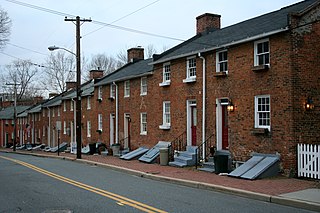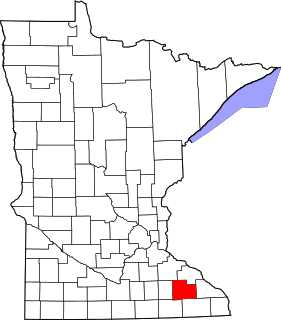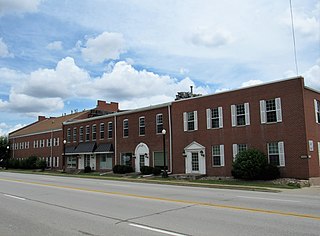
Mississippi State University for Agriculture and Applied Science, commonly known as Mississippi State University (MSU), is a public land-grant research university adjacent to Starkville, Mississippi. It is classified among "R1: Doctoral Universities – Very High Research Activity" and has a total research and development budget of $239.4 million, the largest in Mississippi. It is enrolls more students than any other college or university in the state.

John Marshall Stone was an American politician from Mississippi. A Democrat, he served longer as Governor of that state than anyone else, from 1876 to 1882 and again from 1890 to 1896. He approved a new constitution in 1890 passed by the Democratic-dominated state legislature that disfranchised most African Americans, excluding them from the political system. They were kept out for nearly 70 years.

Murray State University (MSU) is a public university in Murray, Kentucky. In addition to the main campus in Calloway County in southwestern Kentucky, Murray State operates extended campuses offering upper level and graduate courses in Paducah, Hopkinsville, Madisonville, and Henderson.

Fair Park is a recreational and educational complex in Dallas, Texas, United States, located immediately east of downtown. The 277-acre (112 ha) area is registered as a Dallas Landmark and National Historic Landmark; many of the buildings were constructed for the Texas Centennial Exposition in 1936.

Guilford is an unincorporated community located in Howard County in the state of Maryland. The location is named after the Guilford Mill. Guilford is near Kings Contrivance, one of the nine "villages" of Columbia.

Oella is a mill town on the Patapsco River in western Baltimore County, Maryland, United States, located between Catonsville and Ellicott City. It is a 19th-century village of millworkers' homes.

Mississippi Veterans Memorial Stadium is an outdoor football stadium in Jackson, Mississippi, United States. Mississippi Veterans Memorial Stadium has been the home stadium of the Jackson State Tigers football team since 1970. Originally known as War Veterans Memorial Stadium, it was later known as Hinds County War Memorial Stadium. It was redesigned and enlarged in 1960 and Ole Miss vs. Arkansas dedicated Mississippi Memorial Stadium in 1961 before a capacity crowd of 46,000. With political support from Ole Miss and Mississippi State and leadership from Ole Miss Athletics Director Warner Alford, Mississippi Memorial Stadium was enlarged to 62,500 in 1981 and on September 26, 1981 Ole Miss and Arkansas again dedicated the facility before 63,522.

The King Edward Hotel, built in 1923 as the Edwards Hotel, is an historic hotel in downtown Jackson, Mississippi. The second of two buildings located on the site at the corner of Capitol and Mill Streets, it was closed and vacant for nearly 40 years before renovations began in 2006. The hotel was listed on the National Register of Historic Places in 1976, and declared a Mississippi Landmark in 1990. It was restored from 2007-2009 as a combination of apartments and the Hilton Garden Inn Jackson Downtown, which opened on December 17, 2009. It features the King Edward Grill, King Edward Bar, Pavilion Pantry convenience mart, a fitness center and formerly a Seattle's Best Coffee shop.

North Uxbridge is a village and a post office in the town (township) of Uxbridge in Worcester County, Massachusetts, United States. The postal zip code is 01538. It is classified as a community or populated place located at latitude 42.088 and longitude -71.641 and the elevation is 266 feet (81 m). North Uxbridge appears on the Uxbridge U.S. Geological Survey Map. Worcester County is in the Eastern time zone and observes DST. North Uxbridge is located about 36 miles WSW of Boston, and 15 miles SE of Worcester. The town meeting in 1885 set aside North Uxbridge as a "special district", since its population had exceeded 1000 people. North Uxbridge appeared to be a separate Census tract in the 1960 census with a population of 1882. In 2013, an Uxbridge DIY show, The Garage, with Steve Butler, went worldwide from Steve's garage in North Uxbridge.

This is a list of the National Register of Historic Places listings in Dakota County, Minnesota. It is intended to be a complete list of the properties and districts on the National Register of Historic Places in Dakota County, Minnesota, United States. Dakota County is located in the southeastern part of the U.S. state of Minnesota, bounded on the northeast side by the Upper Mississippi River and on the northwest by the Minnesota River. The locations of National Register properties and districts for which the latitude and longitude coordinates are included below, may be seen in an online map.

This list is of the properties and historic districts which are designated on the National Register of Historic Places or that were formerly so designated, in Hennepin County, Minnesota; there are 186 entries as of October 2021. A significant number of these properties are a result of the establishment of Fort Snelling, the development of water power at Saint Anthony Falls, and the thriving city of Minneapolis that developed around the falls. Many historic sites outside the Minneapolis city limits are associated with pioneers who established missions, farms, and schools in areas that are now suburbs in that metropolitan area.

The Church of St. Wenceslaus is a Catholic church in New Prague, Minnesota, United States, constructed in 1907. The church is flanked by a 1908 rectory and a 1914 parochial school, and the three-building complex is listed on the National Register of Historic Places for its association with the Czech American settlement of south-central Minnesota.

This is a list of the National Register of Historic Places listings in Olmsted County, Minnesota. It is intended to be a complete list of the properties and districts on the National Register of Historic Places in Olmsted County, Minnesota, United States. The locations of National Register properties and districts for which the latitude and longitude coordinates are included below, may be seen in an online map.

Price's Mill, also known as Calliham's (Callaham's) Mill, Stone's Mill, and Park's Mill, is a water-powered gristmill about 2 mi (3 km) east of the town of Parksville on South Carolina Highway 33-138 at Stevens Creek in McCormick County. Its name in the USGS Geographic Names Information System is Prices Mill. It was built in the 1890s and was named to the National Register of Historic Places on November 22, 1972. At this time, it was one of the few remaining water-powered gristmills in South Carolina.

Shields Woolen Mill is located along the edge of the Mississippi River in Davenport, Iowa, United States. It has been listed on the National Register of Historic Places since 1983. The building has been repurposed as commercial and office space called One River Place.

Mississippi Mills was a cotton and wool textile manufacturing complex that operated in Wesson, Mississippi, during the latter half of the 19th century. By 1892, Mississippi Mills was described as the largest industry of its kind in the South.

The Lambrite–Iles–Petersen House is an historic home located in the Hamburg Historic District in Davenport, Iowa, United States. The district was added to the National Register of Historic Places in 1983. The house was individually listed on the Davenport Register of Historic Properties in 2012. This was the first residence built in the city in the Italian villa style and one of the earliest examples in the state of Iowa. The house is named for three of its early owners: Joseph Lambrite, a lumber mill owner who built the house, Dr. Thomas Iles, a physician, and John H.C. Petersen, who founded Davenport's largest department store that grew to become Von Maur.

The Great Mill Disaster was an industrial disaster that occurred in Minneapolis, Minnesota, United States in 1878. The disaster, one of the worst in both the city and state's history, resulted in 18 deaths. The explosion occurred on the evening of May 2, when an accumulation of flour dust inside the Washburn A Mill led to a dust explosion that killed the fourteen workers inside the mill. The resulting fire destroyed several nearby mills and killed a further four millworkers. The destruction seriously impacted the city's productive capacity for flour, which was a major industry in the city at the time. Following the blast, Cadwallader C. Washburn had a new mill, designed by William de la Barre, on the site of the old one. This building was also later destroyed, and today the building's ruins are a National Historic Landmark and operated as part of the Mill City Museum.



















